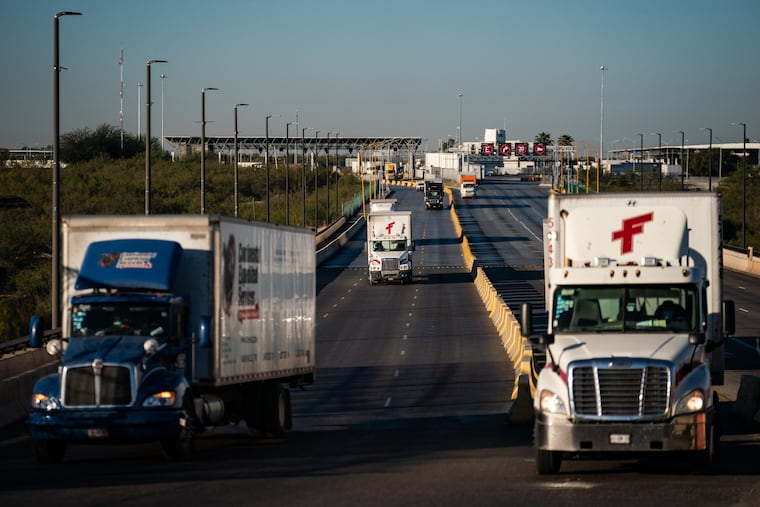In the age of tariffs, recycling is a national security issue
The future of American energy independence, national security, and the day-to-day lives of citizens depends on infrastructural investments that prioritize recycling, writes Emma Whitehouse.

On Dec. 3, China banned the export of critical minerals such as gallium, germanium, and antimony. These minerals are used for military applications, semiconductors, and renewable energy. The escalating global trade war, spurred by President-elect Donald Trump’s promise of tariffs and existing chip sanctions under the Biden administration, raises the question of how America’s economy will function during this standoff.
Trump’s campaign promise that he will implement 25% tariffs on all goods imported from Canada and Mexico, alongside a 60% tariff on all goods from China, has sparked rapid responses from both private companies and governments across the globe. Some companies have preemptively diversified their supply chains away from China in response to the 2018-19 trade war; others are planning on raising their prices, or negotiating with their vendors.
The future of American energy independence, national security, and the economic well-being of citizens depends on infrastructural investments that prioritize recycling. Additionally, domestic recycling programs could give rise to new manufacturing jobs in historically disenfranchised communities.
A classic example of the impact of tariffs is the early 1960s “Tariff Chicken War,” in which European nations imposed a tariff on American chicken imports. In retaliation, President Lyndon Johnson implemented a 25% tariff on light trucks, such as Volkswagens, imported into the U.S. This tariff is still in effect today, and might be a reason why American-made trucks, such as Ford, are so popular. But, the tariff still impacts prices, with trucks becoming increasingly unaffordable for middle-class families.
Tariffs historically do not work to lower the cost of goods or increase American manufacturing. The Tax Foundation, an international research think tank, wrote earlier this year, “At least a dozen estimates on Trump’s proposed tariffs show they will have a harmful effect on the American economy, supporting the standard view among economists that tariffs reduce trade and distort production, leading to lower standards of living.”
But, despite those projections, Trump may be able to implement tariffs unilaterally, with or without support from Congress.
It’s worth noting the importance of critical metals with China’s preemptive response to both the existing Biden administration mandates and Trump’s promised tariffs. Critical metals and minerals are integral for technological and manufacturing needs. Often decontextualized, these metals are vital for the computing, transportation, and energy sectors. It’s crucial to know that America does not independently produce these metals and minerals, with the 2023 U.S. Department of the Interior U.S. Geological Survey finding that the U.S. was over 50% net import reliant in 2022, with Canada and China supplying the largest number of these nonfuel mineral commodities. (Net import reliance refers to the percentage of a mineral commodity used by the U.S. that must be imported from another country.)
China provided 26 commodities that were greater than 50% of net import reliance for the U.S., while Canada provided 20 mineral commodities, and Mexico provided nine mineral commodities. While tariffs may theoretically allow for an increase in American manufacturing, the raw materials necessary to produce items are not always accessible domestically. But that isn’t to say that the domestic supply of metals and minerals can’t be strengthened.
Many raw materials, such as glass, aluminum, and steel can be nearly infinitely recycled. Steel has a 100% recyclability rate, and “[accounts] for more than $520 billion in economic output and nearly two million jobs in 2017 when considering the direct, indirect [supplier] and induced impacts,” according to the American Iron and Steel Institute.
Furthermore, more complex components of semiconductors can be recycled, with research underway to increase the scale and feasibility of recycling programs.
Keeping resources, both imported and domestically manufactured, usable is integral to national security. Projections of primary ores suggest that supplies will be exhausted in 50 years. Not all raw materials are renewable, and while tariffs may increase American mining in both the short and long term, deposits of individual ores are not evenly spread across the globe.
The Rust Belt, formerly called the “Steel Belt” colloquially refers to the heartlands of the U.S. that once produced manufactured items, steel, and coal. Encompassing the Midwest, urban revitalization efforts have been implemented, with Detroit receiving global recognition for renewal efforts that focus on auto innovation, tourism, and community vitality. Revitalizing these cities with material recovery facilities could allow these communities to meet new economic needs.
Tariffs may be put into place to increase American manufacturing and our bipartisan focus should be on making the American dream accessible to all Americans. This will require careful planning, cooperation, and civility. Focusing on recycling and renewability could revitalize our heartland in uncertain times — it isn’t a Democratic talking point, but rather a necessity for a vital and strong America.
Emma Whitehouse has a master of bioethics degree from the University of Pennsylvania and is currently pursuing a doctorate in communication, culture, and media at Drexel University.